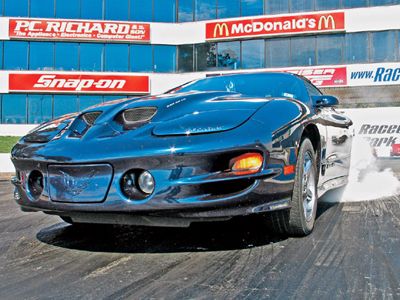
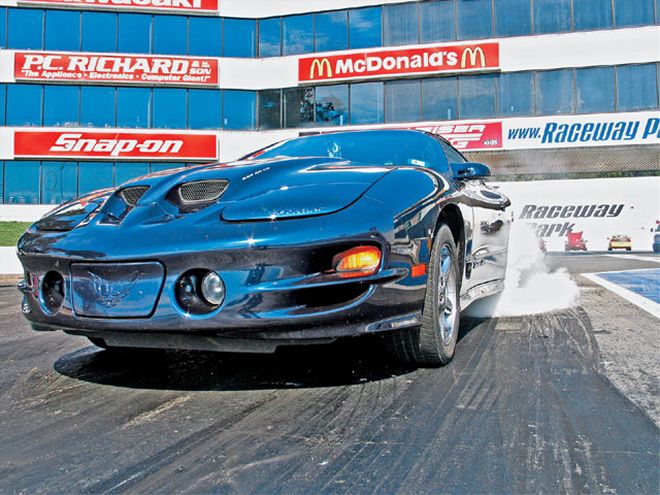 We were back with our subject '99 T/A (LS1, auto, 3.23) to test SLP's 400HP PerformancePac. This time, a pair of Nitto Extreme Drag Radials (245/50R-16) were mounted on the stock wheels for good hook and strip-test results.
We were back with our subject '99 T/A (LS1, auto, 3.23) to test SLP's 400HP PerformancePac. This time, a pair of Nitto Extreme Drag Radials (245/50R-16) were mounted on the stock wheels for good hook and strip-test results.
Our plan was to test the merits of SLP's PerformancePac line on an LS1 T/A. To recap what was accomplished thus far, we successfully strip-tested SLP's 350HP PerformancePac on a bone-stock '99 T/A owned by Kelly Holloway (Dec. '06 HPP), which lowered e.t.'s over 0.3 and added 3 mph to trap speed. Next (Jan. '07 HPP), we moved up to the 375HP Pac. Though we attempted a strip test, the additional 21 rwhp and 13 lb-ft of torque revealed in dyno testing and the four-year-old, dry-rotted tires conspired to limit traction. Because of that bad track experience, we ordered a set of Nitto Extreme Drag Radials to properly test the SLP's next stage-the 400HP Pac.
Dyno-testing the 350HP Pac provided 347 flywheel horsepower as converted accounting for 20 percent driveline loss using the 289-rwhp figure of SLP's chassis dyno. After installing the 375HP Pac, the LS1 developed 310 rwhp on the chassis dyno, equal to 372 hp at the crank. SLP's PerformancePac power ratings are based on the flywheel horsepower of the '01-'02 LS1s, which come from the factory with the LS6 intake as standard equipment. To ensure we could easily surpass those ratings with a '99 LS1, we opted for the popular LS6-intake swap for this story. SLP's LS6 intake includes the hardware and will enable us to retain the legal EGR emissions equipment.
The LS6-manifold swap was performed at SLP's installation center (which has been reopened to the public). During the swap, we cut off the part of the EGR tube that disrupts airflow into the intake. SLP's catalog states: "Add up to 15 hp to your LS1 with the LS6 intake manifold." After changing intakes, the blue Bird was strapped down to SLP's in-house dyno (which also has been reopened to the public). When we spun the rollers, we realized a 17-rwhp gain! That's impressive considering we didn't touch the computer or anything else. Now we were up to 327 rwhp and happy to be beyond the Pac's 375 hp rating with 392 at the crank.
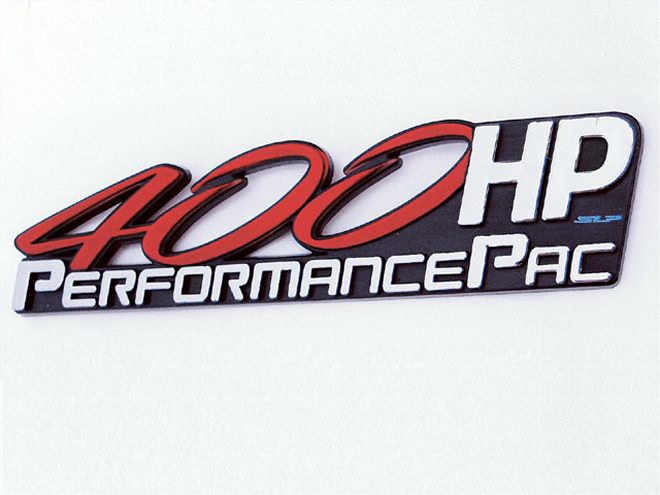
400HP PerformancePac
Pleased with the results, we were anxious to install, dyno, and strip-test SLP's 400HP Pac, which includes everything we already installed and tested from the 350HP and 375HP Pacs plus SLP's tuned-length, long-tube stainless steel headers. The headers include a high-flow, 3-inch Y-pipe but require the install kit and high-flow cats to keep the Bird flying legal.
LS1 F-body header installation is not a walk in the park and needs to be done on a lift by a competent technician. It can take anywhere from 8 to 12 hours. SLP's engineering fabricator, Ken Estelle, handled the task in roughly 8 hours.
Upon post-install startup, we enjoyed the deeper and louder tone when revving it up, but the engine actually seemed quieter at idle. Remarkably, at highway-cruising speed, interior-exhaust drone was reduced. This is due to the long tuned-length tubes (SLP has a patent on its headers) that work together with each exhaust pulse to produce a smoother and more solid-sounding exhaust tone. Still, full-throttle blasts will get people's attention.
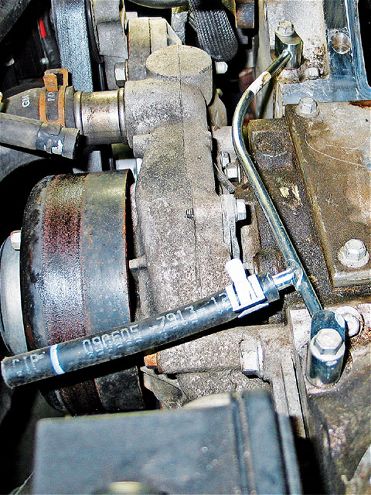 The short coolant line (PN 30041K) and rear block-off blocks (not seen, bolted to the rear side of the heads) will be installed just as the factory did to fit the LS6 intake to the LS engine. Even without the line flowing coolant to the rear of the heads, GM engineers didn't see any adverse effects in keeping the hot LS6 cool.
The short coolant line (PN 30041K) and rear block-off blocks (not seen, bolted to the rear side of the heads) will be installed just as the factory did to fit the LS6 intake to the LS engine. Even without the line flowing coolant to the rear of the heads, GM engineers didn't see any adverse effects in keeping the hot LS6 cool.
On The Dyno
With the T/A safely strapped to the SuperFlow dyno, SLP's director of engineering, Hank Daniecki, put the hammer down. Peak power was now up to 349 rwhp and peak torque was 352 lb-ft. The headers dramatically broaden the power curve. Now there's over 300 rwhp from 4,500 to 6,500 rpm. Before the headers, 300-plus rwhp was only between 4,800 to 6,000 rpm. Peak at the flywheel was up to 418 hp. This had us surpassing the 400HP Pacs' rating, which was our goal.
Ironically, without the LS6-intake swap, we would have just made it to the 400hp mark. Now the T/A can proudly wear its 400HP PerformancePac badges!
Strip-Test Prep
When the Poncho was on the lift receiving its headers, we decided it would be wise to install SLP's bolt-in subframe connectors. With the added power and sticky tires, we wanted to stiffen the chassis to prevent possible creases in the quarter-panels. On the 30-minute ride home, the Bird felt much more solid (like a full-frame car), without any T-top or dash rattles.
Next, the Nitto Extreme Drag Radials were mounted (Shore Wheels, Tuckerton, New Jersey) on the stock 16-inch wheels. Afterwards, tire spin was virtually nonexistent on the streets. Pre-Nittos, out of the hole, and on a WOT one-two up-shift, the car wanted to go sideways and off the road. Now prepared with the SLP frame connectors and new Nittos, it felt safer and more surefooted for our return to Raceway Park.
It was a hot and humid, early-October, Indian Summer-type day upon arrival at E-town, New Jersey. The temperature rose to 82 degrees, which is not conducive to low e.t.'s as compared to cool 50-degree air. We popped the hood and flipped the fan switch to let the LS1 engine cool down from the 90-minute ride. Tire pressure was adjusted to 40 psi for the fronts and 22 psi for the rears. In past testing, we have found drag radials work best with anywhere from 18-24 psi, depending on vehicle weight.
Due to the added weight of the frame connectors (30 pounds), we were surprised when the scales showed us a test weight of 3,690 pounds (test weight for the 350 and 375 Pacs was 3,680 pounds). At a test weight of only 10 extra pounds, we figured the weight savings must have been from the lighter headers versus the heavier cast-iron manifolds because even the fuel level was the same.
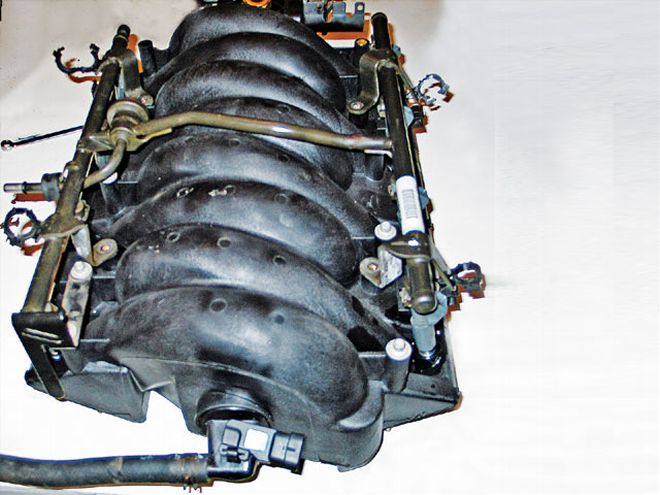 We swapped all the parts (injectors, fuel rails, brackets, hoses, and throttle body) from the LS1 manifold to the LS6 without any modifications. (It's important to attach the power-brake hose, shown connected to the vacuum port, at the back of the manifold.) The back of the manifold also has a connection for manifold vacuum and the MAP sensor. We will connect them before the intake is bolted in place, because once its bolted on, we can't get our hands back there.
We swapped all the parts (injectors, fuel rails, brackets, hoses, and throttle body) from the LS1 manifold to the LS6 without any modifications. (It's important to attach the power-brake hose, shown connected to the vacuum port, at the back of the manifold.) The back of the manifold also has a connection for manifold vacuum and the MAP sensor. We will connect them before the intake is bolted in place, because once its bolted on, we can't get our hands back there.
After a one-hour cool-down, we went to the line with the needle just coming off the 160-degree mark. This was after a 6-second burnout to heat up the new Nitto drag radials. Off the line, I looked at the board and noticed a decent 1.96 60-foot without any hint of tire spin. The T/A boogied down the track. On the return road, I looked up and saw the score, a 12.83 at 107.77 mph. We pulled right back up to the line for our usual minute-later hotlap and slowed to a 12.95 at 106.83 mph.
Though we were expecting mid-12s, we shouldn't with the lousy air (for the time of year). The weather conditions were possibly costing us a few tenths and mph. We made two more pairs of passes with cool-downs and couldn't manage to go quicker. We'll just have to persuade the T/A's owner to get to the track when the air is cool and crisp (35-55 degrees).
Conclusion
Installing and testing each stage of SLP's PerformancePacs proved to be well worth the effort. With better, cooler air, mid-12s may have been possible, as stated in SLP's catalog for its 400HP Pac. The LS6 intake and SLP headers proved themselves as very effective power producers. Now with over 400 flywheel horsepower, the owner can remain fearless if a new GTO pulls up alongside her SLP-equipped T/A.